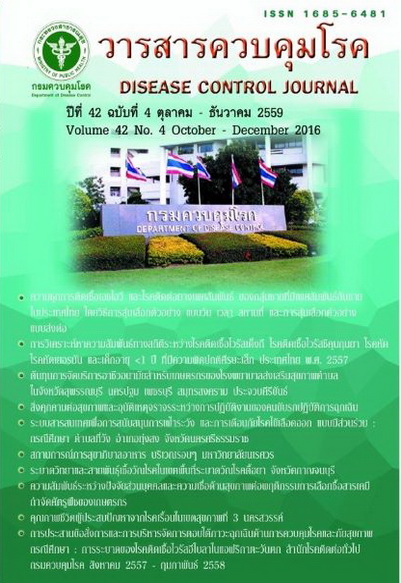Epidemiology and genotypes of Mycobacterium tuberculosis at an outbreak area in Kanchanaburi province
DOI:
https://doi.org/10.14456/dcj.2016.7Keywords:
drug resistant tuberculosis, spoligotype, MIRU-VNTRAbstract
Tuberculosis (TB) is one of the leading public health problems. Genotypic characterization of My¬cobacterium tuberculosis (MTB) is useful for epidemiological investigation and tracking of TB transmission. This study aimed to genetically identify and observe transmission of MTB by analyzing DNA fingerprints of tubercle bacilli isolated from pulmonary TB patients who were registered at an outbreak area of Thamaka district, Kanchanaburi province in 2013-2014. Sixty-eight DNA samples including twenty multidrug-resistant (MDR), and five mono-resistant MTB either to isoniazid or rifampicin were genotyped based on spoligo¬typing and subtyped using Mycobacterial interspersed repetitive unit-variable number of tandem repeat (MI¬RU-VNTR). The results revealed that 34 of 68 (50.00%) isolates belonged to Beijing genotype (SIT No. 1). Other twelve and seven new spoligotypes were identified. The major cumulative subtype of Beijing cluster was MDR-TB, and 14 of these had identical MIRU-VNTR genotype. This evidence linked to the strains of M. tuberculosis that have been found at an MDR-TB outbreak in Thamaka district, Kanchanaburi province since the year 2002. It suggests that this area still has MDR-TB transmission which cannot be eliminated over the time. MTB genotyping, proper measures of TB prevention and control should be contin¬ued.
Downloads
References
2. สำนักข่าวแห่งชาติ กรมประชาสัมพันธ์. สาธารณสุขจังหวัดกาญจนบุรี พัฒนาระบบการจัดบริการดูแลรักษา ลดอัตราการเสียชีวิตและการแพร่ระบาดของวัณโรคดื้อยาหลายขนานในจังหวัดกาญจนบุรี [อินเทอร์เน็ต]. [สืบค้นเมื่อ 18 มิ.ย. 2559]. แหล่งข้อมูล: http://thainews.prd.go.th/website_th/news/news_detail/ TNSOC5805140010105
3. สำนักวัณโรค กรมควบคุมโรค กระทรวงสาธารณสุข. แนวทางการดำเนินงานควบคุมวัณโรคแห่งชาติ พ.ศ. 2556 [อินเทอร์เน็ต]. [สืบคืนเมื่อ 19 ม.ค. 2559]. แหล่งข้อมูล: http://e-lib.ddc.moph.go.th/pdf /eb333/eb333.pdf
4. ชุลีพร จิระพงษา, ธนพล หวังธีระประเสริฐ, ณรงค์ เห็นประเสริฐแท้, จันทิรา สุขะสิฐษ์วณิชกุล, นาฎพธู สงวนวงศ์, ลัดดาวัลย์ ปัญญา, และคณะ. การระบาดของ วัณโรคดื้อยาในชุมชน อ.ท่ามะกา จ.กาญจนบุรี 2545 - มิถุนายน 2553. วารสารสมาคมเวชศาสตร์ป้องกันแห่งประเทศไทย 2554;3:262-71.
5. Wells CD, Cegielski JP, Nelson LJ, Laserson KF, Holtz TH, Finlay A, et al., HIV infection and multidrug-resistant tuberculosis: the perfect storm. J Infect Dis 2007;196 Suppl 1:S86- 107.
6. Regmi SM, Chaiprasert A, Kulawonganunchai S, Tongsima S, Coker OO, Prammananan T, et al. Whole genome sequence analysis of multi¬drug resistant Mycobacterium tuberculosis Bei¬jing isolates from an outbreak in Thailand. Mol Genet Genomics 2015; doi 10.1007/s00438 -015-1048-0.
7. Disratthakit A, Meada S, Prammananan T, Thaipisuttikul I, Doi N, Chaiprasert A. Genotypic diversity of multidrug-, quinolone- and exten¬sively drug-resistant Mycobacterium tuberculosis isolates in Thailand. Infect Genet Evol 2015; 32:432-9.
8. van Embden JD, Cave MD, Crawford JT, Dale JW, Eisenach KD, GicqueI B, et al. Strain iden¬tification of Mycobacterium tuberculosis by DNA fingerprinting: recommendations for a standard¬ized methodology. J Clin Microbiol 1993;31 :406-9.
9. Sukkasem S, Yanai H, Mahasirimongkol S, Yamada N, Rienthong D, Palittapongarnpim P, et al. Drug resistance and IS6110-RFLP patterns of Mycobacterium tuberculosis in patients with recurrent tuberculosis in northern Thailand. Microbiol Immunol 2013;57:21-9.
10. Brudey K, Driscoll JR, Rigouts L, Prodinger WM, Gori A, Al-Hajoj SA, et al. Mycobacterium tuberculosis complex genetic diversity: mining the fourth international spoligotyping database (SpolDB4) for classification, population genetics and epidemiology. BMC Microbiol 2006;6:1- 17.
11. Filliol I, Driscoll JR, Soolingen DV, Kreiswirth BN, Kremer K, Valtudie G, et al. Global distri¬bution of Mycobacterium tuberculosis spoligo¬types. Emerging Infectious Diseases 2002;8: 1347-9.
12. Allix-Béguec C, Harmsen D, Weniger T, Supply P, Niemann S. Evaluation and strategy for use of MIRU-VNTRplus, multifunctional database for online analysis of genotyping data and phyloge¬netic identification of Mycobacterium tuberculosis complex isolates. J Clin Microbiol 2008;46: 2692-9.
13. Homolka S, Post E, Oberhauser B, George AG, Westman L, Dafae F, et al. High genetic diver¬sity among Mycobacterium tuberculosis complex strain from Sierra Leone. BMC microbiol 2008;8:103.
14. Faksri K, Drobniewski F, Nikolayevskyy V, Brown T, Prammananan T, Palittapongarnpim P, et al. Genetic diversity of the Mycobacterium tuberculosis Beijing family based on IS6110, SNP, LSP and VNTR profiles from Thailand. Infect Genet Evol 2011;11:1142-9.
15. Demay C, Liens B, BurguiereT, Hill V, Couvin D, Millet J, et al. SITVITWEB- a publicly available international multimarker database for studying Mycobacterium tuberculosis genetic diversity and molecular epidemiology. Infect Genet Evol 2012;12:755-66.
16. Supply P, Allix C, Lesjean S, Cardoso-Oele¬mann M, Rusch-Gerdes S, Willery E, et al. Pro¬posal for standardization of optimized mycobac¬terial interspersed repetitive unit-variable-number tandem repeat typing of Mycobacterium tubercu¬losis. J Clin Microbiol 2006;44: 4498-510.
17. van Soolingen D, Qian L, de Haas PE, Douglas JT, Traore H, Portaels F, et al. Predominance of a single genotype of Mycobacterium tuberculosis in countries of east Asia. J Clin Microbiol 1995;33:3234-8.
18. European concerted action on new generation genetic markers and techniques for the epidemi¬ology and control of tuberculosis. Beijing/W genotype Mycobacterium tuberculosis and drug resistance. Emerg Infect Dis 2006;12:736-43.
19. Bifani PJ, Mthema B, Kurepina NE, Kreiswirth BN. Global dissemination of the Mycobacterium tuberculosis W. Beijing family strain. Trends Microbiol 2002;10:45-52.
20. Wang J, Liu Y, Zhang CL, Ji BY, Zhang LZ, Shao YZ, et al. Genotypes and characteristics of clustering and drug susceptibility of Mycobacte¬rium tuberculosis isolates collected in Heilong-jiang Province, China. J Clin Microbiol 2011; 49:1354-62.
21. Nakajima C, Tamaru A, Rahim Z, Poudel A, Maharjan B, Aye KS, et al. Simple multiplex PCR Assay for Identification of Beijing Family Mycobacterium tuberculosis Isolates with a lineage-specific mutation in Rv0679c. J Clin Microbiol 2014;51:2025-32.
22. Klopper M, Warren RM, Hayes C, Pittius NCGV, Streicher EM, Müller B, et al. Emer¬gence and spread of extensively and totally drug-resistant tuberculosis, South Africa. Emerg Infect Dis 2013;19:449-55.
23. Lopez B, Aguilar D, Orozco H, Buger M, Espitia C, Ritacco V, et al. A marked difference in pathogenesis and immune response induce by different Mycobacterium tuberculosis genotypes. Clin Exp Immunol 2003;133:30-37.
24. Mokrousov I, Ly HM, Otten T, Lan NN, Vyshnevskyi B, Hoffner S, et al. Origin and primary dispersal the Mycobacterium tuberculo¬sis Beijing genotype: clues for human phyloge¬ography. Genome Res 2005;15:1357-64.
Downloads
Published
How to Cite
Issue
Section
License
Articles published in the Disease Control Journal are considered as academic work, research or analysis of the personal opinion of the authors, not the opinion of the Thailand Department of Disease Control or editorial team. The authors must be responsible for their articles.






